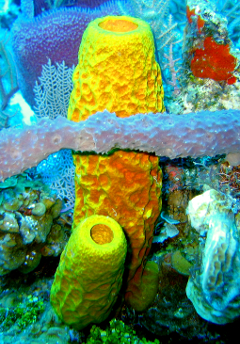Sponge sinks studied
 Experts say sponges and marine algae may have an important role in absorbing carbon dioxide from the ocean and atmosphere.
Experts say sponges and marine algae may have an important role in absorbing carbon dioxide from the ocean and atmosphere.
Biogeochemist Dr Terry Isson’s latest research tells the story of a delicate dance of organisms and chemical reactions responsible for maintaining the balance of CO2 levels in Earth’s atmosphere.
Dr Isson says there are two processes happening in our oceans that over time have helped maintain Earth’s CO2 levels and its temperature. Scientists call the processes “weathering” and “reverse weathering”.
When silicate minerals are broken down, silica and aqueous cations (water dissolved ions) are produced. If these ingredients lead to the formation of carbonate, they permanently remove CO2 from the environment. This process is called silicate weathering.
Alternatively, if carbonates are not formed and conditions lead to the formation of marine clays, CO2 is released into the environment. This process is reverse weathering.
It is all controlled by the silica secreting organisms in oceans including sponges, diatoms (marine algae) and radiolarians (single cell eukaryotes).
Prior to around 550 million years ago, silica secreting organisms were not yet prevalent in the Earth’s oceans. Their absence allowed for more extensive marine clay formation, the process that releases CO2 into the atmosphere, says Dr Isson.
“Before the evolution of silica-secreting eukaryotic life, early oceans were more silica-rich, and this would have fuelled more rapid rates of reverse weathering, releasing more CO2 into the atmosphere,” says Dr Isson.
Today, with more sponges and diatoms (marine algae) radiolarians present in the ocean, there is less extensive reverse weathering happening and, as a result, more CO2 being removed from Earth’s ocean and atmosphere, he says.
Put simply, Dr Isson’s research suggests the success or demise of these silica secreting organisms in our oceans play a dominant role in regulating the climate on Earth.
Dr Isson’s research has seen him analyse rock samples spanning the last 3 billion years of Earth’s history, from more than 50 geologic sites around the world, stretching from the Grand Canyon to India.
Contained in these old rocks are records of the chemistry of seawater from the past. From these records he has unlocked stories of how the processes of weathering and reverse weathering have evolved over Earth’s history.
Simple mass balance calculations, using a lithium dataset, supports the idea that the evolution of silica secreting organisms drove a substantial decline in baseline CO2 levels on Earth.
“Understanding the global carbon budget in our oceans is an important area of study because by looking backwards into history we can work out how quickly these processes happen and better shape our view of the future,” he said.







 Print
Print